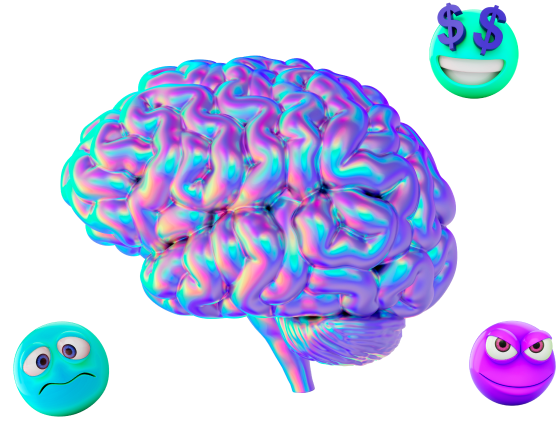Hulpmiddelen en scholing > De psychologie van het handelen
In de psychologie van het handelen wordt gekeken naar de mentale en emotionele componenten die een rol spelen bij het nemen van besluiten tijdens het handelen. Deze aspecten komen naar voren in de persoonlijkheid en het gedrag van een handelaar en zijn van invloed op de handelsresultaten.
Deze karaktereigenschappen uiten zich op verschillende manieren, bijvoorbeeld via angst, hebzucht, arrogantie of verwachtingen. Van deze vier emoties hebben angst en hebzucht de grootste invloed op de psychologie van het handelen, vooral als het gaat om het nemen van risico's en discipline.
Te hebzuchtig zijn kan leiden tot het nemen van te riskante beslissingen. Maar als je te bang bent loop je het risico kansen te missen of te voorzichtig te handelen, waardoor je weinig winst boekt. Door je zelfbewustzijn te ontwikkelen kan je als handelaar terugkerende negatieve gedragspatronen herkennen en begrijpen hoe die een gezond beoordelingsvermogen in de weg staan.
Zo kan een handelaar zijn gedrag onder de loep nemen en objectievere en rationelere handelsbeslissingen nemen.

In de handelspsychologie wordt gekeken naar waarom handelaren mogelijk onverstandige beslissingen nemen op de markt of bij andere financiële zaken. Behavioral finance is eigenlijk een combinatie tussen psychologie en financiën en onderzoekt de invloed van het menselijke gedrag op financiële keuzes en handelsresultaten.
Er wordt hierbij gekeken naar psychologische invloeden en vooroordelen die bepalend zijn voor het gedrag van handelaren en financiële professionals en naar hoe dit gedrag de marktresultaten kan beïnvloeden. Aan de hand van behavioural finance kunnen we ook inzicht krijgen in de verschillende uitkomsten van diverse sectoren en bedrijfstakken.
Bovendien gaat behavioral finance ervan uit dat financiële deelnemers niet volledig rationeel handelen of een perfecte zelfbeheersing hebben. In plaats daarvan worden ze beïnvloed door psychologische factoren en is er sprake van relatief normale neigingen tot zelfbeheersing. Behavioural finance houdt ook in dat besluitvorming op het gebied van financiën mede wordt bepaald door iemands mentale en fysieke welzijn.
Dat betekent dat onze mentale toestand onderhevig is aan verandering, naar gelang van ons algemene welzijn. Onder de meest voorkomende behavioural biases noemen we overmoed, kuddegedrag, mentale boekhouding, emotional gap (het verschil tussen de emotionele reacties van beleggers en de werkelijke prestaties van een belegging), het verankeringseffect, zelfattributie en verliesaversie.


Een andere populaire term binnen de handelspsychologie is emotioneel handelen (of emotioneel beleggen). Bij emotioneel handelen wordt, net als bij behavioral finance, gekeken naar impulsief gedrag, dat wordt aangewakkerd door marktvolatiliteit. Dat leidt ertoe dat een handelaar activa koopt of verkoopt op emotionele gronden.
Emotioneel handelen kan worden getriggerd door bepaalde gevoelens, zoals paniek, hebzucht, opwinding, angst of overmoed.
Enkele veelvoorkomende voorbeelden van emotionele handelsbeslissingen zijn overtraden, paniekverkopen en confirmation bias (bevestigingsvooroordeel). Om grip te krijgen op emotioneel handelen is emotionele intelligentie nodig. Zo kunnen we onze zelfsdiscipline behouden en psychologische stressfactoren beheersen.
Door voortdurend te leren en te investeren in persoonlijke ontwikkeling kan een handelaar essentiële vaardigheden verwerven zoals zelfregulering, empathie en zelfvertrouwen.

Een ander belangrijk aspect binnen de handelspsychologie zijn de zogenaamde handelsinstincten, dat wil zeggen, intuïtieve of onderbuikgevoelens die handelaren kunnen ervaren bij het nemen van beslissingen op financiële markten.
Om op deze intuïtieve gevoelens te kunnen vertrouwen, is een grote mate van zelfbewustzijn nodig. Handelaren moeten eveneens in staat zijn om legitieme, rationele beslissingen te onderscheiden van beslissingen die worden ingegeven door een emotionele impuls. We moeten ons realiseren dat zogenaamde objectiviteit vertekend of vertroebeld kan zijn door vooroordelen en dat we stappen moeten ondernemen om dat probleem te verhelpen.
Drie van de meest voorkomende psychologische aspecten die invloed hebben op rationele besluitvorming zijn zintuiglijke vertekening (een mening vormen op basis van mogelijk vertekende informatie), het vermijden van het onzekere (of angst voor het onbekende) en tastbaarheid van anticipatie (waarbij men zich richt op het gevoel van anticipatie in plaats van op het bereiken van de aanvankelijk verwachte resultaten).

T4Trade, met geregistreerd adres F20, 1st Floor, Eden Plaza, Eden Island, Seychelles, is een handelsmerk van Tradeco Limited.
Damadah Holding Limited, met het geregistreerde adres 365 Agiou Andreou, Efstathiou Court, Flat 201, 3035 Limassol, Cyprus, faciliteert diensten aan Tradeco Limited, inclusief maar niet beperkt tot betalingsdiensten.
Tradeco limited is bevoegd en wordt gereguleerd door de Seychelles Financial Services Authority met licentienummer SD029.
Risicowaarschuwing:
Onze producten worden verhandeld op marge en brengen een hoog risico met zich mee. U kunt al uw kapitaal verliezen. Deze producten zijn mogelijk niet geschikt voor iedereen en u dient er zeker van te zijn dat u de daaraan verbonden risico's begrijpt.
T4Trade is niet gericht op inwoners van de EU, waar het geen licentie heeft. T4Trade biedt haar diensten niet aan aan inwoners van bepaalde gebieden, zoals de Verenigde Staten, Iran, Cuba, Soedan, Syrië en Noord-Korea.
Juridische documenten